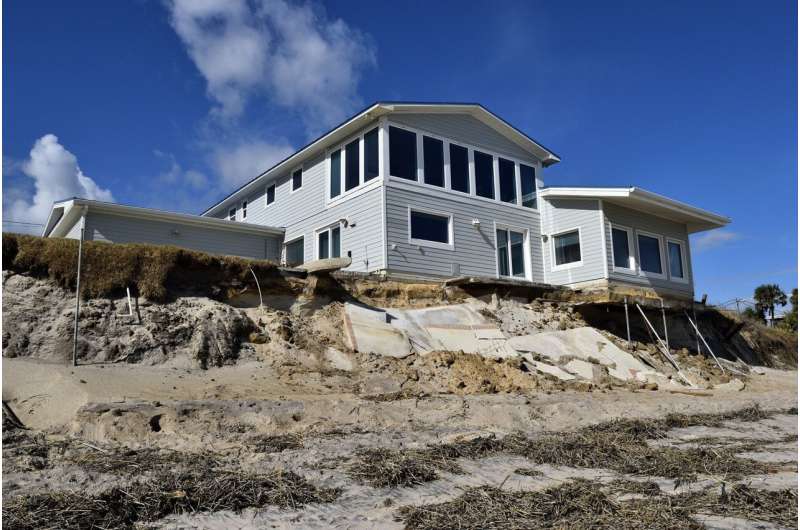This article has been reviewed according to Science X's editorial process and policies. Editors have highlighted the following attributes while ensuring the content's credibility:
fact-checked
trusted source
written by researcher(s)
proofread
How rising sea levels will affect our coastal cities and towns

Sea-level rise—along with increasing temperatures—is one of the clearest signals of man-made global warming. Yet exactly how rising water levels affect the coast is often misunderstood.
A new coastal hazard assessment for Victoria's Port Phillip Bay has again thrown the spotlight on the impact of sea-level rise on coastal communities in Australia. Should we be worried? Or is the reality more nuanced?
While there are still many uncertainties, even a small change in sea level can have big impacts. We should be doing all we can to limit sea-level rise to protect our coastal cities and towns. And because sea levels will continue to rise for centuries after we cut emissions to net zero, planning decisions for coastal areas must factor this in.
Why are sea levels rising?
Global sea levels are rising for two main reasons: the oceans are getting warmer, and land-based ice sheets and glaciers are melting.
As ocean water warms, it expands. Because the ocean basins are finite (like a bathtub), this results in a rise in water levels.
Since the 1970s, thermal expansion of the oceans has accounted for roughly half of measured global sea-level rise. The other half is due to land-based ice melt from ice sheets and glaciers. Together, these make up what is known as "eustatic" sea level.
The rate of sea-level rise experienced at the coast also depends on whether the land is moving up or down. "Relative" or "isostatic" sea level is the sum of "eustatic" sea level plus local vertical land movement.
Australia is rising by about 0.3–0.4 millimeters a year due to glacial isostatic adjustment. This is the result of the land continuing to move upward following the loss of ice on land during previous glaciations. The land subsided under the weight of this ice and is now rebounding as the ice is gone. This slow rebound of the land provides a small offset to eustatic sea levels around Australia.
Sea-level rise is accelerating
From 1900 to 2018, global sea levels rose by about 20 cm (a long-term average of 1.7 mm/yr), but almost everywhere the rate of rise is increasing. Measurements since 1993, when global satellite data became available, show the rate of global mean sea-level rise over the past decade has more than doubled to more than 4mm/yr.
Around Australia, sea levels are rising at or above this global average. Tide gauges indicate the rate of rise in northern Australia since the early 1990s is around 4–6 mm/yr. Along the south-east coast of Australia, it's about 2–4 mm/yr. Rates of sea-level rise are not uniform around Australia because of local effects like ocean circulation and tidal processes.
Even if greenhouse gas emissions reached zero tomorrow, sea levels will continue to rise for several centuries because of the slow response of the ocean to warming. It's a long-term trend that we must live with.
This is why is it important to factor in sea-level rise when we make planning decisions along the coast. Unfortunately, the rate of sea-level rise over the coming century remains highly uncertain, making it difficult to include in coastal planning.
The "likely" range of the most recent projections by the Intergovernmental Panel on Climate Change (IPCC) is a rise of between 0.4 meters and 0.8 m by 2100. However, a rise of nearly 2 m by 2100 and 5 m by 2150 cannot be ruled out. This is due to deep uncertainty about ice-sheet processes—so much so, that in 2021 the IPCC introduced a new high-end risk scenario to describe this.
Small rises have big impacts
The impact of sea-level rise at the coast is not just a gradual increase in water lapping at the shore. An increase in tide heights (both higher high tides and higher low tides) increases the probability of coastal flooding and erosion when storms come along.
As a rule of thumb, every 10 cm of sea-level rise triples the frequency of a given coastal flood. Another rule of thumb, known as the Bruun Rule, suggests a 1 cm rise in sea level leads to a 1m retreat of the coastline.
While these back-of-the-envelope estimates are often significantly reduced when local conditions are accounted for, it explains why a small shift in the mean sea level can have big impacts at the coast.
Storms aren't always bad for the beach
Most of the impacts of sea-level rise around Australia's coast will be felt in combination with storm events, such as east coast lows or tropical cyclones. A high water level plus a storm surge on top leads to a storm or "king" tide. In combination with storm waves, it can cause significant coastal erosion and flooding.
However, storms also bring sand from deeper water towards the beach. Over the long term, this process can help beaches keep pace with sea-level rise. Fortunately for eastern Australia, we have a lot of sand sitting offshore which is slowly making its way back to our beaches. Other naturally regressive coastlines, such as many in Northern Europe, are not so lucky.
All eyes on Antarctica
Sea-level rise is here to stay and gathering pace, but the rate of future increase remains uncertain. It largely depends on what happens in Antarctica over the coming decades.
This in turn depends on land and sea temperatures around the southern continent, which are directly linked to our efforts to limiting global warming to 1.5°C in line with the Paris Agreement.
With over 250 million people now living on land less than 2 m above sea level, most in Asia, it is imperative we do everything we can to limit future sea-level rise.
Provided by The Conversation
This article is republished from The Conversation under a Creative Commons license. Read the original article.![]()





















